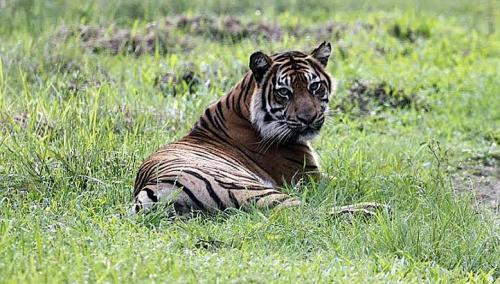Following India’s success in protecting endangered tigers, Cambodia says it wants to get some of the big cats from India and reintroduce them to its Cardamoms mountain range.
Indonesia, which has only an estimated 500 Sumatran tigers at most left in the wild, recently released two into protected forests in southern Sumatra. Even Scotland and England will soon reintroduce the Eurasian lynx that died out there more than 1,000 years ago.
The practice is much coveted; the survival of a big predator at the top of a food chain amounts to an ultimate quality stamp for an ecosystem. There is the glamour quotient as well: Big predators like tigers are charismatic ― and attract funding.
Susi Pudjiastuti, Indonesia’s Minister of Maritime Affairs and Fisheries, was at the release of the Sumatran tigers on March 3 at the 450 sq. km Tambling Wildlife and Nature Conservation Area (TWNC) on the southern edge of the 3,500 sq. km sprawl of Bukit Barisan Selatan National Park. She welcomed the move.
But it is a risky business. Reintroducing a big predator is not easy, especially in populated Asia. In general, they roam wide areas. Five tigers released so far in the TWNC, fitted with satellite collars, have been tracked walking 200 km per week. If there are not enough prey animals to go round for the newcomers, the predator could roam farther in search of food, encountering humans, killing livestock and getting into sometimes deadly conflict with people.
If the tiger, for example, was raised in captivity and thus overly familiar with people, it may not have a natural fear of people. This could also increase the chances of close encounters.
Indonesia, which has only an estimated 500 Sumatran tigers at most left in the wild, recently released two into protected forests in southern Sumatra. Even Scotland and England will soon reintroduce the Eurasian lynx that died out there more than 1,000 years ago.
The practice is much coveted; the survival of a big predator at the top of a food chain amounts to an ultimate quality stamp for an ecosystem. There is the glamour quotient as well: Big predators like tigers are charismatic ― and attract funding.
Susi Pudjiastuti, Indonesia’s Minister of Maritime Affairs and Fisheries, was at the release of the Sumatran tigers on March 3 at the 450 sq. km Tambling Wildlife and Nature Conservation Area (TWNC) on the southern edge of the 3,500 sq. km sprawl of Bukit Barisan Selatan National Park. She welcomed the move.
But it is a risky business. Reintroducing a big predator is not easy, especially in populated Asia. In general, they roam wide areas. Five tigers released so far in the TWNC, fitted with satellite collars, have been tracked walking 200 km per week. If there are not enough prey animals to go round for the newcomers, the predator could roam farther in search of food, encountering humans, killing livestock and getting into sometimes deadly conflict with people.
If the tiger, for example, was raised in captivity and thus overly familiar with people, it may not have a natural fear of people. This could also increase the chances of close encounters.

There is also the risk of the tiger being killed by poachers or local livestock owners. Hostile humans worried about their livestock or children are unlikely to guarantee the survival of a big predator.
So while it may seem like a sound idea to reintroduce tigers brought from India into Cambodia’s wilds, India is likely to require watertight guarantees of protection. After all, Cambodia’s tiger population has been almost wiped out; during years of instability and war they were killed by poachers and, more recently, have lost habitat to species like deer and wild boar, as well as to logging and plantations.
Once, Cambodia had a few hundred tigers, but no more than 30 are left in the entire country. India, by contrast, has more than 2,200 today ― almost double the 1,400 in 2006.
The TWNC project shows the potential for partnerships between wildlife protection departments and private individuals or companies.
While corporations are sometimes accused of “green-washing” ― donating money to environmental projects to give the impression of compensating for more widespread damage they often cause to the environment ― it is also undeniable that the private sector often has more resources than government departments. For instance, Malaysia’s Sime Darby Foundation ― spawned by the palm oil giant ― supports a last-ditch Sumatran rhino breeding project in Sabah.
There are only about 100 left in small scattered populations and captive breeding offers an option to save them from extinction.
The TWNC itself is supported by the sometimes controversial Indonesian tycoon Tomy Winata, who owns buildings in downtown Jakarta and has a passion for tigers specifically and wildlife in general. He spends around $2 million out of his own pocket every year on the TWNC.
In fact, Winata runs it in an arrangement with the government. Since 2008, he has been taking “conflict tigers” into captivity there and has thus far released five into the wild. Eight more are in cages at his facility. (“Conflict tigers” are those that have run into problems with people, killing livestock and sometimes even mauling or killing people.)
This is a problem in Indonesia, where oil palm and acacia plantation eat into forest habitats. Ministry of Forestry data as of 2013 indicated that up to 1.1 million hectares of forest was being lost every year. Tigers often find themselves wandering in plantations and have to be captured and removed.
The TWNC project is somewhat unorthodox, though. Around 4,000 families live in the area. But Winata insists that it has “thousands” of deer, wild boar and monkeys ― the staple prey of the tigers ― and so the big cats leave people alone. But he adds: “We are lucky there is no conflict between tigers and humans.”
TWNC also takes care to build relations with the communities, he said. New York-based Alan Rabinowitz, sometimes called the “Indiana Jones” of conservation for his exploits and his willingness to work in unorthodox settings, like the former military dictatorship in Myanmar ― has so far cautiously supported the project.
Panthera, the organization he heads, now helps monitor TWNC’s tigers and other wildlife. Data has indicated “an unexpected density of six tigers per 100 sq. km in the southern region of TWNC” ― nearly double the highest recorded for the area to date ― its website says.
“These findings, including camera-trap images of tiger cubs, have identified Tambling, which is part of the globally significant BBSNP, as a beacon of hope for the last remaining wild Sumatran tigers,” it says.
The released tigers are closely monitored and Winata has the wherewithal to maintain his own security force.
In a phone interview, he acknowledged: “The most important issue is not how to release the tigers in the jungle. The most critical thing is how to protect them.”
But for Vidya Athreya, who works with the U.S.-based Wildlife Conservation Society’s program in India and has studied leopards in habitats where they coexist with people, the real challenge is more complex.
Athreya believes resources may be better spent trying to address the conflict situations that are at the core of the issue. The question is why there is a steady supply of “conflict tigers” in Indonesia ― or for that matter, “conflict leopards” in India.
She says, “It’s easy to fence off and protect. But it is much harder to deal with the situations that produce conflict in the first place.”
By Nirmal Ghosh
(The Straits Times)
-
Articles by Korea Herald



![[Herald Interview] 'Amid aging population, Korea to invite more young professionals from overseas'](http://res.heraldm.com/phpwas/restmb_idxmake.php?idx=644&simg=/content/image/2024/04/24/20240424050844_0.jpg&u=20240424200058)
















